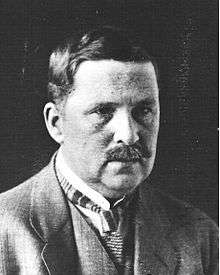Alvar Palmgren
Alvar Palmgren (28 April 1880 – 30 November 1960) was a Finnish botanist and plant ecologist.
Alvar Palmgren | |
|---|---|
 | |
| Born | 28 April 1880 |
| Died | 30 November 1960 (aged 80) |
| Nationality | Finland |
| Alma mater | University of Helsinki |
| Scientific career | |
| Fields | botany, plant ecology |
| Institutions | University of Helsinki |
| Doctoral advisor | J.P. Norrlin |
| Author abbrev. (botany) | Palmgr. |
Palmgren studied botany at the University of Helsinki under professor J.P. Norrlin. He graduated (Fil.kand.) in 1906 and obtained his Ph.D. in 1914. He became docent of botany at the University of Helsinki 1916 and professor of botany at the same university in 1928 (from 1938, the first in the special Swedish-language chair of botany). He retired in 1950.[1]
Research
Palmgren worked as a systematic botanist with microspecies of Taraxacum, Hieracium and other genera. As an ecologist, he worked of the nature of plant communities. He supported the ideas of Henry Gleason on the individualistic behaviour of species in community assembly already from the 1920s.[2] Palmgren wrote early accounts on the role of isolation and stochastic events in the distribution of species, while his contemporary biology was largely deterministic.[3][4][5]
Jaccard dispute
In the 1920s, Palmgren entered in a heated dispute with the Swiss botanist and phytogeographer Paul Jaccard over the interpretation of Jaccard's species-to-genus ratio. Palmgren had observed a decrease in species richness from west to east in the Åland Islands, his main geographical scene of scientific inquiry.[3] He interpreted this as an effect of isolation from the Swedish mainland to the west, and the associated lower species-to-genus ratio as a random sampling effect. In contrast, Jaccard held that the lower species-to-genus ratio towards the east was an effect of decreased diversity in habitat conditions and increased competitive exclusion.[6] The Swiss botanist Arthur Maillefer showed statistically that genera accumulate much faster than species and that therefore Paul Jaccard's biological explanation of the pattern was unnecessary since it could be fully explained as a statistical sampling effect.[7] An analytical solution with the same result was provided by the Hungarian mathematician George Pólya.[8] In essence, this disagreement were repeated by Charles Elton[9] vs. C. B. Williams and again reiterated by Peter Grant and Daniel Simberloff in the 1970s.
Miscellaneous
Palmgren was on the board of Societas pro Fauna et Flora Fennica from 1916. He was chairman 1920–1957.
In addition to his botanical work, Palmgren made an impressive political act as a 22-year-old student. He initiated and led a movement among young Finnish men to refuse conscription service in the Russian Emperial Army. A rescript of 1900 by Nicholas II of Russia, sovereign of the Grand Duchy of Finland, put Finnish conscripts under the Russian military top. The 'strike' movement forced a withdrawal by 1905.
Alvar Palmgren was the father of the zoologist Pontus Palmgren (born 1907).
References
- Collander, Runar (1965) The History of Botany in Finland. With an Appendix on Forest Science by Yrjö Ilvessalo. Societas Scientiarum Fennica Helsinki, 159 pp.
- A Letter from Henry A. Gleason, written 1952, printed in Brittonia 39: 2 (1987), pp. 205–209.doi
- Palmgren, A. (1921) Die Entfernung als pflanzengeographischer Faktor (Isolation as a phytogeographical factor). Series Acta Societatis pro Fauna et Flora Fennica 49 (1)
- Palmgren, A. (1925) Die Artenzahl als pflanzengeographischer Charakter sowie der Zufall und die säkulare Landhebung als pflanzengeographischer Faktoren. Ein pflanzengeographische Entwurf, basiert auf Material aus dem åländischen Schärenarchipel (The number of species as phytogeographical character as well as chance and land uplift as phytogeographical factors, based on studies in the Åland Islands). Fennia 46 (2).
- Palmgren, A. (1926) Chance as an element in plant geography. In: Proceedings of the International Congress of Plant Sciences, Ithaca, New York (Duggar, B.M. ed.) vol. 1: 591–602
- Järvinen, Olli (1982) Species-to-genus ratios in biogeography: a historical note. Journal of Biogeography 9 (4): 363-370.
- Maillefer, A. (1929). "Le Coefficient générique de P. Jaccard et sa signification". Mémoires de la Societé Vaudoise de Sciences Naturelles. 3 (4): 113–183.
- Pólya, G. (1930). "Ein Wahrscheinlichkeitsaufgabe in der Pflanzensociologie". Vierteljahrsschrift der Naturforschenden Gesellschaft in Zürich. 75: 211–219.
- Elton, C. (1946) Competition and the structure of ecological communities. Journal of Animal Ecology 15 (1): 54-68
- IPNI. Palmgr.